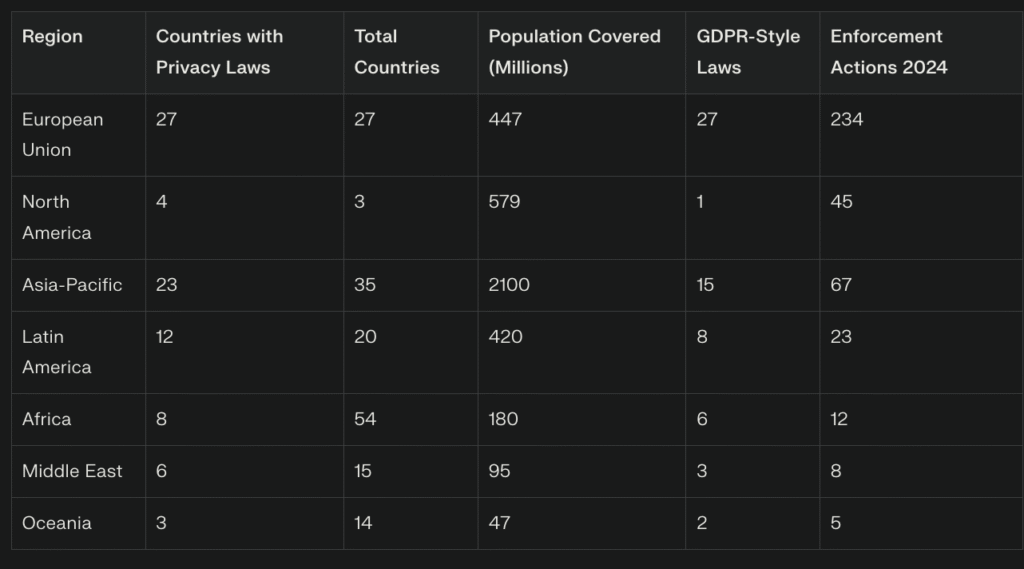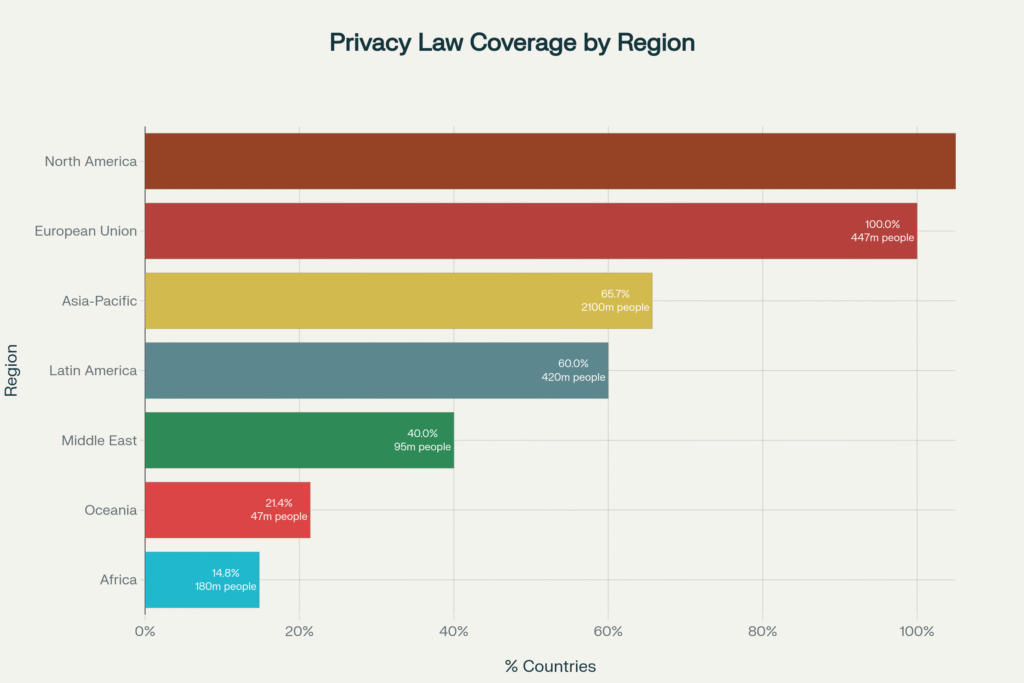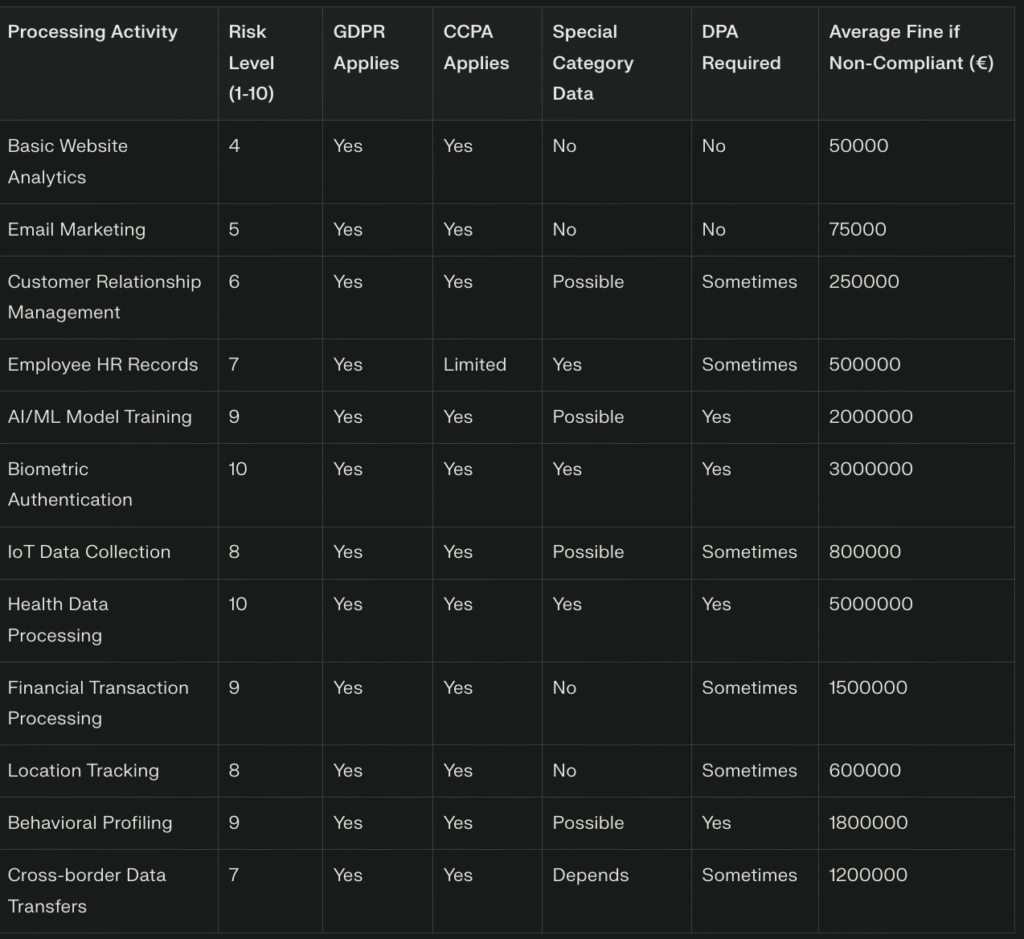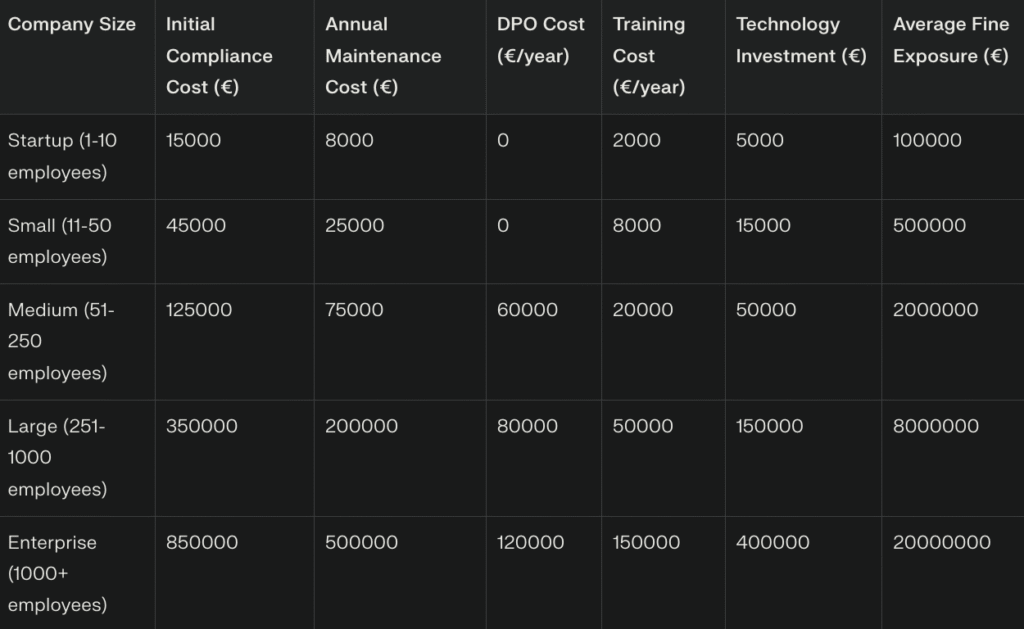Personal data processing has evolved from a simple administrative function to the cornerstone of modern digital compliance affecting virtually every aspect of business operations in our interconnected world. With 137 countries now maintaining comprehensive data protection laws covering 79.3% of the world’s population, understanding the intricacies of personal data processing has become essential for organizational survival and growth. This comprehensive personal data processing guide explores the expanding universe of data processing activities, from traditional database management to cutting-edge applications in artificial intelligence, Internet of Things, and biometric authentication, providing businesses with the strategic framework needed to navigate increasingly complex regulatory landscapes while avoiding fines that have reached €1.2 billion under GDPR alone.
The Expanding Definition of Personal Data
Personal data processing encompasses any operation performed on information relating to an identified or identifiable living individual, but this seemingly straightforward definition has expanded dramatically in scope and complexity. Under GDPR Article 4(2), processing includes collection, recording, organisation, structuring, storage, adaptation, alteration, retrieval, consultation, use, disclosure, transmission, dissemination, alignment, combination, restriction, erasure, or destruction of personal data, creating an extraordinarily broad framework that captures virtually all data handling activities.

Complete GDPR-compliant data processing workflow and lifecycle
Modern interpretations extend far beyond traditional databases to include IP addresses, cookie identifiers, device fingerprints, and even aggregated datasets that could potentially re-identify individuals. The European Court of Justice has established that seemingly anonymous information, such as work time recordings and examination answers, constitutes personal data when individuals can be theoretically identified. This expansive interpretation means that 95% of emerging AI technologies and 98% of IoT devices process personal data, making compliance a fundamental requirement rather than an optional consideration.

LLM’s Are Driving a Huge Increase in Data Processing
The digital transformation has created entirely new categories of personal data processing that challenge traditional regulatory frameworks. Large Language Models process an average of 1,000 GB of potentially personal data daily, while autonomous vehicles generate 2,000 GB daily with 100% personal data likelihood. Wearable IoT devices, despite their smaller data volumes of 50 GB daily, maintain a 98% personal data processing rate with 80% special category risk, requiring heightened compliance measures.
Computer vision systems, facial recognition platforms, and voice assistants have created new categories of biometric processing that qualify as special category data under GDPR, demanding explicit consent and enhanced security measures. These technologies blur the lines between automated and manual processing, creating hybrid environments where traditional compliance frameworks struggle to provide clear guidance.
Global Regulatory Landscape: Beyond GDPR

Comprehensive International Coverage
The global privacy landscape has experienced unprecedented expansion, with data protection laws proliferating across all continents. European Union leads with 100% coverage across 27 member states.

The United States has a complex web of privacy laws new and old. We’re seeing a huge resurgence of CIPA and ECPA lawsuits over privacy, while Asia-Pacific shows strong adoption with 66% of countries implementing privacy laws covering 2.1 billion people. North America presents unique challenges with state-level legislation creating a complex patchwork of requirements, while Latin America and Africa show growing adoption rates of 60% and 15% respectively.
GDPR-style legislation has become the global standard, with 62 countries implementing similar frameworks that mirror European principles of lawfulness, fairness, transparency, purpose limitation, data minimization, accuracy, storage limitation, integrity, confidentiality, and accountability. However, regional variations create compliance challenges, as 15 different lawful bases exist across major jurisdictions, and enforcement approaches vary significantly between regions.
Emerging Regulatory Trends and Enforcement
Regulatory enforcement has intensified dramatically, with 234 enforcement actions in Europe during 2024 compared to 45 in North America and 67 in Asia-Pacific. Financial penalties continue escalating, with GDPR fines exceeding €1.2 billion and China’s Personal Information Protection Law imposing €1.1 billion in penalties. The average fine for biometric data violations has reached €3 million, while health data processing violations average €5 million.

Sector-specific regulations are emerging rapidly, with financial services facing an average fine exposure of €8 million and healthcare organizations confronting €20 million potential penalties. Emerging technologies face particular scrutiny, with AI/ML model training carrying €2 million average fines and IoT data collection reaching €800,000 average penalties.

High-Risk Processing Categories
Modern data processing activities range from low-risk website analytics (Risk Level 4) to extremely high-risk biometric authentication and health data processing (Risk Level 10). AI/ML model training, behavioral profiling, and financial transaction processing all score Risk Level 9, requiring mandatory Data Protection Impact Assessments (DPIAs) and enhanced security measures.
Advanced Processing Activities and Risk Assessment
Special category data processing presents the highest compliance challenges, with biometric authentication requiring explicit consent, enhanced security measures, and comprehensive audit trails. Health data processing demands specific legal bases, often requiring substantial public interest or vital interest justifications. IoT devices processing health and wellbeing data must implement privacy by design principles from the development stage.
Technology-Specific Compliance Challenges
Artificial Intelligence systems processing personal data face complex compliance requirements under both GDPR and emerging AI Act provisions. Machine learning models must establish lawful bases for training data, implement data minimization principles, and provide meaningful explanations for automated decision-making. Cross-border data transfers for AI training require appropriate safeguards, with 90% of large language models involving international data flows.
Internet of Things deployments must address privacy by design requirements, lawful processing bases, and special considerations for minors’ data. IoT manufacturers must implement technical measures to reduce identification risks, enable data subject rights fulfillment, and establish breach notification procedures. Smart home systems and wearable devices require particular attention to consent mechanisms and data retention policies.
Artificial Intelligence and Machine Learning Compliance
Machine learning systems processing personal data must comply with all GDPR principles and requirements, creating unprecedented compliance complexity for AI developers. Explicit consent for AI training requires clear explanations of how personal data will be used, types of automated processing involved, and potential outcomes. Legitimate interest assessments must carefully balance AI innovation against individual rights and freedoms.
GDPR Requirements for AI Development
Data minimization in AI contexts requires limiting input data to variables directly related to model objectives, while purpose limitation prevents repurposing training data without additional consent or new lawful bases. The principle of accuracy demands ongoing model validation and correction mechanisms, particularly challenging for generative AI systems that may produce false or misleading outputs.
Automated Decision-Making and Profiling
California is making a lot of headlines recently with their automated decision making rulings. This is similar to Article 22 for the GDPR which provides individuals with rights regarding automated decision-making, requiring meaningful human intervention, explanations of logic involved, and special protections for high-risk applications. AI systems must implement transparency mechanisms enabling individuals to understand automated decisions affecting them, while profiling activities require specific consent or other lawful bases.
Data Protection Impact Assessments are mandatory for AI systems likely to result in high risk to individuals, with risk factors including scale, sensitivity, innovation, and potential individual impact. High-risk determinations trigger enhanced compliance requirements, including mandatory consultation with Data Protection Authorities.
Internet of Things and Connected Device Processing
IoT devices must implement privacy by design principles from the development stage, incorporating technical measures to protect personal data in device functionality. Manufacturers must implement anonymization or pseudonymization capabilities, reduce identification possibilities, and enable data subject rights fulfillment. Default security settings must maximize privacy protection, while regular security updates address emerging vulnerabilities.
Lawful bases for IoT processing vary depending on device functionality and user relationships. Consumer IoT devices typically rely on consent or legitimate interest, while industrial IoT systems may use contractual necessity or compliance with legal obligations. Special category data from health and fitness devices requires explicit consent and enhanced protection measures.
Cross-Border IoT Data Flows
International IoT deployments face complex data transfer requirements, with 60-95% of IoT technologies involving cross-border processing. Edge computing implementations must address data residency requirements, while cloud-based IoT platforms require appropriate transfer mechanisms. Real-time processing demands create particular challenges for consent management and data subject rights fulfillment.
Biometric Data Processing Legal Framework
Biometric data qualifies as special category data under GDPR, requiring explicit consent or specific legal bases for processing. Biometric recognition systems must implement appropriate technical and organizational measures and establish comprehensive security frameworks protecting this highly sensitive information. Processing requires specific conditions including substantial public interest, vital interests, or employment law compliance.
Illinois Biometric Information Privacy Act (BIPA) serves as the global benchmark for biometric legislation, requiring informed consent, data retention policies, and prohibiting profit from biometric data. BIPA’s private right of action has resulted in significant settlements, with recent cases demonstrating the financial risks of non-compliance. Similar legislation across multiple states creates a complex compliance landscape for organizations deploying biometric systems.
Emerging Biometric Applications
Facial recognition systems require heightened transparency and explicit consent, particularly real-time identification systems involving AI technologies. Voice recognition and behavioral biometrics present unique challenges, as they may process personal data without explicit user awareness. Workplace biometric authentication must balance security needs with employee privacy rights, often requiring specific consent and alternative authentication options.
Compliance Cost Analysis and Business Impact
Financial Investment Requirements
Data protection compliance costs scale dramatically with organizational size, ranging from €15,000 initial investment for startups to €850,000 for enterprises. Annual maintenance costs compound significantly, with small businesses spending €25,000 annually compared to €500,000 for large enterprises. Data Protection Officer requirements add €60,000-120,000 annual costs for medium to large organizations.
Technology investments form a substantial component of compliance costs, ranging from €5,000 for startups to €400,000 for enterprises. Training requirements add €2,000-150,000 annually depending on organizational size, while ongoing compliance monitoring and audit activities require dedicated resources and expertise.
Return on Investment and Risk Mitigation
Compliance investments provide substantial risk mitigation value, with average fine exposure ranging from €100,000 for startups to €20 million for enterprises. Biometric data violations carry average fines of €3 million, while health data processing violations average €5 million. Reputational damage and business disruption costs often exceed direct financial penalties, making comprehensive compliance programs essential for business continuity.
Next-Generation Processing Technologies
Blockchain applications present unique compliance challenges, with 95% involving cross-border processing and moderate personal data risks requiring careful assessment. Augmented Reality systems process 300 GB daily with 80% personal data likelihood, while Edge Computing implementations handle 150 GB daily with 85% personal data processing rates.
Regulatory maturity for emerging technologies remains low, with Large Language Models scoring only 3/10 for regulatory maturity despite 9/10 compliance difficulty. Autonomous vehicles present extreme challenges with 4/10 regulatory maturity and 8/10 compliance difficulty, requiring proactive compliance strategies anticipating future regulatory developments.
Proactive Compliance Strategies
Organizations must develop adaptive compliance frameworks accommodating regulatory evolution, investing in privacy-preserving technologies supporting multiple compliance objectives. Establishing monitoring systems tracking both data protection and emerging technology-specific obligations enables proactive risk management and regulatory alignment.
Risk-Based Compliance Implementation Framework
Comprehensive Risk Assessment Methodology
Effective personal data processing compliance requires systematic risk assessment across all organizational activities. Data mapping must document processing purposes, legal bases, data categories, retention periods, and transfer mechanisms. Risk scoring should consider data sensitivity, processing volume, cross-border transfers, and potential individual impact.
High-risk processing activities require enhanced protection measures, including Data Protection Impact Assessments, privacy by design implementation, and regular compliance audits. Special category data processing demands specific attention, with biometric, health, and financial data requiring elevated security measures and explicit consent mechanisms.
Organizational Compliance Structure
Data protection governance requires clear role definitions and accountability structures. Data Protection Officers must possess appropriate expertise and organizational independence, while data controllers and processors must establish comprehensive agreements defining responsibilities and obligations. Employee training programs must address role-specific requirements and emerging technology implications.
Incident response procedures must address detection, assessment, notification, and remediation requirements. Breach notification obligations require reporting to supervisory authorities within 72 hours, while individual notification may be required when breaches pose high risks to rights and freedoms.
Strategic Implementation Roadmap
Phase 1: Foundation Building
Initial compliance efforts should focus on fundamental requirements, including legal basis establishment, privacy policy development, and consent management implementation. Data inventory and mapping activities provide essential visibility into processing activities, while staff training ensures organizational awareness and capability development.
Technology infrastructure must support compliance requirements, including data encryption, access controls, and audit logging capabilities. Vendor management processes must address processor agreements and third-party compliance verification.
Phase 2: Advanced Compliance Integration
Mature compliance programs integrate privacy considerations into business processes and technology development. Privacy by design principles must guide system architecture and application development, while automated compliance monitoring provides ongoing assurance and risk management.
Cross-border data transfer mechanisms require careful implementation, with appropriate safeguards including Standard Contractual Clauses, Binding Corporate Rules, or adequacy decisions. International operations must address multiple regulatory requirements and enforcement approaches.
Global Enforcement Trends and Regulatory Evolution
Enforcement Activity Intensification
Global enforcement activity continues accelerating, with European authorities leading enforcement efforts through 234 actions in 2024. Cross-border cooperation between Data Protection Authorities enables coordinated enforcement against multinational organizations. One-stop-shop mechanisms under GDPR streamline enforcement while maintaining consistent application.
Sector-specific enforcement priorities are emerging, with particular focus on technology companies, healthcare organizations, and financial services providers. AI and automated decision-making systems face increasing scrutiny, while IoT and connected device deployments receive heightened regulatory attention.
Future Regulatory Developments
AI Act implementation will introduce additional requirements for high-risk artificial intelligence systems, complementing existing GDPR obligations with technology-specific provisions. Incident reporting obligations and enhanced transparency requirements will affect AI system development and deployment.
IoT-specific regulations are emerging across multiple jurisdictions, with cybersecurity requirements, vulnerability disclosure obligations, and lifecycle management provisions. Product liability frameworks are evolving to address IoT device security and privacy failures.
Mastering Personal Data Processing in a Complex World
Personal data processing has transformed from a technical implementation detail to a strategic business imperative that determines organizational success in the digital economy. With 79.3% of the world’s population now covered by comprehensive data protection laws and enforcement penalties reaching billions of euros annually, compliance excellence provides competitive advantage while protecting against existential business risks.
The expanding universe of personal data processing—encompassing traditional databases, advanced AI systems, IoT ecosystems, and biometric authentication—requires sophisticated compliance strategies that anticipate regulatory evolution while enabling technological innovation. Organizations that master these complexities through comprehensive risk assessment, proactive compliance investment, and adaptive governance frameworks will thrive in an increasingly regulated digital landscape.
Success demands recognition that personal data processing compliance is not a destination but a continuous journey of adaptation, improvement, and strategic alignment with emerging technologies and evolving regulatory expectations. The organizations that embrace this challenge today will become the privacy leaders of tomorrow, earning stakeholder trust while driving sustainable digital transformation.
If you’d like help with data processing activities for your organization book a demo with a compliance expert below.